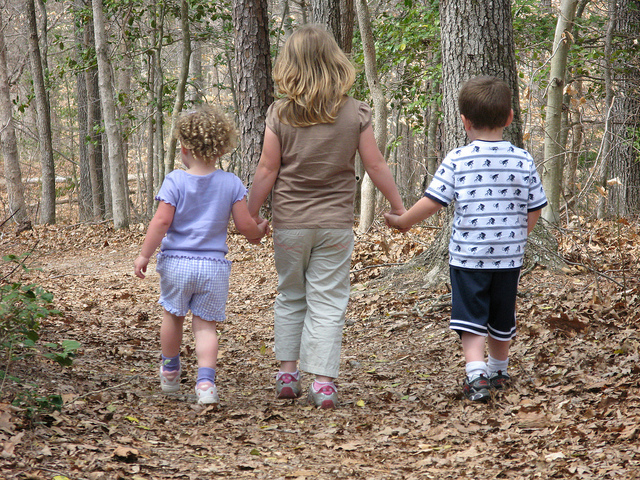When I was a grief counselor at Hospice of Marin, I helped develop a summer camp for children who had lost a parent or family member. Since the camp was located in Sonoma County, with its hiking trails through the woods, we made it an “Adventure Journey Through Grief.”
Children grieve differently from adults in that they work through their emotions in the imaginal realm. Rather than talking about their process, they use symbolism to express themselves. Therefore, in order to help them, you need to meet them where they are with creativity and play.
The counselors and I mapped out our “adventure” hike through the hills, woods and creeks, where at each turn the children were symbolically confronted with the difficult feelings associated with the stages of grief: denial, bargaining, anger, sadness and acceptance. I dressed up like “sadness” and was slumped over a log crying as the children came upon me. In order to pass, they needed to get together in a group and find creative ways to engage me until I felt ready enough to join the group for the rest of the hike.
The other counselors dressed up like angry gremlins, fairy helpers and jokers with riddles until all the challenges were overcome. Having grown larger and all inclusive, our group arrived at the “acceptance” tree. Here our hospice nurse, dressed up like an earth goddess, gave the kids chocolates, as well as pens and paper to make wishes. It was a fun and magical day witnessing how creative and resilient children are when given the opportunity to sort things out in their own way.
Grief is an umbrella term that describes the stages of difficult feelings that we experience when we lose someone we love. Learning how to safely work through overwhelming emotions is also the heart of the Buddhist spiritual journey.
As we progress through the teachings and practices that the Buddha taught in the three “yanas,” we are like these courageous children learning how to face our fears and losses. The reason we come back to working with our emotions in all these different ways—developing our skills and resilience over and over again—is because our confused thoughts and difficult feelings are the clouds that block our knowing of who we truly are: pure and unconditional love. Everything we learn about letting our thoughts go and breathing through our big feelings has to do with our spiritual freedom and peace.
The Buddha’s teachings and practices are laid out perfectly in a progression so that we start slowly and proceed safely. Through our meditation practice, we learn the tools and skills to build a solid foundation internally and build from there. We don’t just head off into the woods alone and unprepared. Like these amazing children, we go step by step, getting all the support we need until we are able to overcome one challenge at a time.
Many people feel that if they even start to feel their grief, they will drown in sadness. The same is true for trauma survivors. This is why we don’t just go in to address the wounds without first preparing a solid ground of resourcefulness and containment inside the psyche. Our mindful work in therapy, as well as our personal meditation practice, can help us progress safely. This is where our mindfulness training is put to good use! We practice touching into our feelings and returning to our breath. We go back and forth like this until we feel confident in our own ability to bring ourselves back.
Practicing caution and safety is wise and mature. It is not to engender fear, but rather it is about gaining awareness and practicing the tools that help us stay grounded. This way we gain confidence in knowing that we can handle it. We know that we can move through this and will come out the other side. We trust that we can meet our feelings when they come up without being taken over by them. Our meditation cushion then becomes our safe place and training ground where we can return again and again to regain our strength.
Author: Tina Fossella, MA, MFT
Editor: Evan Yerburgh
Image: Flickr












Read 0 comments and reply